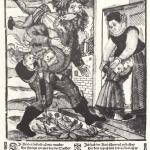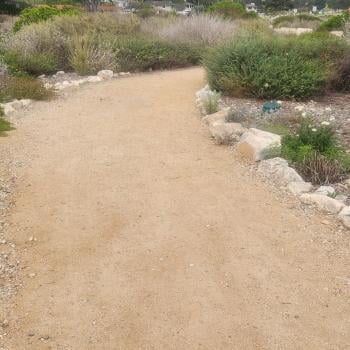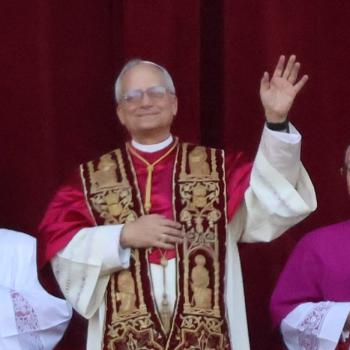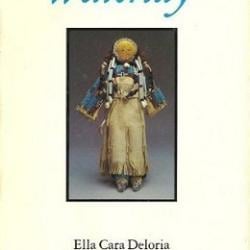St. Mary’s Basilica in downtown Phoenix, Arizona. Listed in the National Register of Historic Places and named a Minor Basilica by Pope John Paul II in 1985
On June 25, 2023, on a blazing hot day in Phoenix, Arizona, my husband, children, and I sat in smooth, wooden pews attending Sunday Mass at St. Mary’s Basilica, where I had proudly delivered my high school valedictorian speech in 1996. Nearly a decade earlier, on September 14, 1987, I had waited anxiously across the street in the shadow of the Phoenix Convention Center to hear Pope St. John Paul II address the crowd from the Basilica’s balcony; I was in fifth grade and had been delighted to find myself quoted in the local paper a few days later. Though I left Phoenix when I was 18, I often visit the Basilica on trips home, especially since I began studying Franciscan history, because the Basilica is a Franciscan church. Only now, it’s not.

Interior of St. Mary’s Basilica. Downtown Phoenix, Arizona. I gave my valedictorian speech from the wooden lectern on the right.
Part of a global trend, the friars announced from the pulpit that after 127 years at the Basilica – the oldest Catholic church in town and the only Catholic church in Phoenix until 1924 – they would no longer minister the parish, and that indeed, this was their last Sunday Mass. Several parishioners began openly weeping. I stood in silent dismay, glancing around to see adults with heads bowed in resignation. The Franciscans were leaving! No longer would I come “home” to the comfort of hearing Mass from the brown-robed mendicants. No longer would friars be seen walking around downtown Phoenix. How would this change affect the parishioners who sought out the parish because it was Franciscan, like the Tongan Catholic community who joined at the rector’s invitation? How would the Basilica change?
[While preparing this post, I discovered that Very Reverend John Muir, Vicar General and Moderator of the Curia for the Diocese of Phoenix, is the new pastor. I met him in San Francisco over two decades ago when he was a seminarian and, prior to his ordination, he came by our home in Phoenix once to help move furniture. He grew up locally and understands the Basilica’s history, and was so quoted in Franciscans celebrate ‘bittersweet’ goodbye at St. Mary’s Basilica, (June 27, 2023).]

Francis and companions on the road, an illustration from Francis of Assisi: The Saint and his wonderful story, a book I purchased in Assisi in 2011 for my future children before I was married
Reverting parishes to the local diocese due to lack of mendicant personnel is not new, it’s a phenomenon that dates back to the earliest years of the Franciscan order in the New World (as I outline below). I became aware of the increasing turnover of Franciscan parishes last June when – in my role as Director of the Great Books Program en español for the Angelicum Academy – I called churches across the country with Spanish-speaking populations to recruit. Several parishes listed online as Franciscan were scheduled to revert to the diocese on July 1, 2022, one year before the Basilica’s own transition on July 1, 2023. Indeed, a quick search online reveals a number of Franciscan parishes losing their friars, some in Europe whose presence dates back 800 years(!), that is, to within a decade of Francis founding the order in 1209. I’ve included a few examples below; most of the articles tout the lack of new vocations and dwindling numbers of aging friars as contributing to their inability to manage large churches and the difficult decision to leave, despite the Franciscans’ historical presence.
- Franciscans leaving Cleveland’s Shrine Church of St. Stanislaus after century of service [December 15, 2011]
- Irish Franciscans to leave Athlone after 800 years [May 10, 2019]
- Farewell at Assumption parish in New Jersey ends nearly a century of service [October 16, 2020]
- Franciscans bid farewell to Waterford [Ireland] after nearly 800 years [October 18, 2022]
Dwindling numbers led six Franciscan provinces in the United States to vote in 2018 to restructure into one large province, as reported in the National Catholic Reporter on May 31, 2018: “Like many other religious communities in the U.S., the Franciscan order is facing a reduction in the number of its members. During the 1960s and 1970s, the number of Friars Minor in the United States peaked at 3,252, but today there are under 1,000 friars.” Changes due to the restructuring are unfolding slowly, so that by October 2023, the six provinces will cease to exist independently. One example of a recent transition prompted by the restructuring is the Franciscan friars in Quincy relinquishing control of the St. Francis Solanus Parish to the Catholic diocese of Springfield, Illinois [February 5, 2022].

Proclamation Day plaque to commemorate the departure of the Friars of the Holy Name Province from the Church of the Assumption of Our Blessed Lady in Wood-Ridge, New Jersey. September 13, 2020
When Sunday Mass ended at the Phoenix Basilica that blazing day in June, I asked the friars why they were leaving, expecting to hear the usual reply, but the pastor’s response surprised me. Rather than lament the lack of new vocations, he explained that the men currently entering the order did not feel called to pastoral or sacramental administration, preferring contemplation and less public-facing ministries. Meeting the pastor’s eye, I nodded in historical understanding. This preference, coupled with the dwindling number of vocations, is forcing the order to re-think its future … by returning to its past.
***
Francesco Bernadone founded the ordo fratrum minorum (Order of Friars Minor or OFM) in 1209 in Assisi, Umbria (now Italy) to fill a unique need in medieval Europe. The lessening threat of invasion during the High Middle Ages had increased internal stability and prompted a cultural revival, with the invention of labor-saving devices and the 3-field system leading to greater food production and a revitalization of trade. The result? Europe’s population doubled between 1,000 and 1,300. The ecclesiastical structures in place were no longer sufficient to minister to the growing populace of Christians in the cities.

The walled medieval city of Assisi, with the enormous Basilica of St. Francis visible on the left
Enter the mendicant orders (Franciscans and Dominicans) who, operating in a space between the cloister of monastic life and the active ministry of secular clergy, preached and provided pastoral care in the cities to those who needed it, with permission of the local bishop. The friars provided something else, too – an option for the newly wealthy who worried about their salvation to give up their possessions and devote their life to Christ in poverty.
What is happening now falls within the expectations of the Franciscan vocation. Importantly, Francis never envisioned his friars remaining stable in any one location, as the Reverend John Doctor, vice president for mission and ministry at Quincy University, stated in the article mentioned above. “If you build a place and that’s the only place you stay at, that’s not what was intended,” he said. “We’re supposed to be itinerant. When we’ve done what needed to be done, we move on. That’s not just an itinerant spirit, that’s the spirituality that we have. One thing Francis did not want, he didn’t want friars to have stability in that sense.”

The original Rule St. Francis penned in 1209 has been lost to history, but we have his third Rule, dated 1223. Section VI states:
“The brothers should appropriate neither house, nor place, nor anything for themselves; and they should go confidently after alms, serving God in poverty and humility, as pilgrims and strangers in this world. Nor should they feel ashamed, for God made himself poor in this world for us. This is that peak of the highest poverty which has made you, my dearest brothers, heirs and kings of the kingdom of heaven, poor in things but rich in virtues. Let this be your portion. It leads into the land of the living and, adhering totally to it, for the sake of our Lord Jesus Christ wish never to have anything else in this world, beloved brothers.”
A few years later in 1226, nearing death and with the order exploding with new members, Francis included a similar admonishment in his Testament:
“The brothers must be careful not to accept any churches, poor dwellings, or anything else constructed for them unless these buildings reflect the holy poverty promised by us in the rule. We should always live in these places as strangers and pilgrims. I firmly command all the brothers, by the obedience they owe me, that wherever they are they should not dare to ask either directly or through an intermediary for any letter from the Roman court to secure a church or any other place, to protect their preaching, or to prevent persecution of their bodies; but wherever they are not received, they should flee into another land and do penance with God’s blessing.”
This Testament remained disputed among Franciscans, so that in 1230 the friars asked Pope Gregory IX if it was binding like the Rule, and he replied that it was not. Even so, many friars treated it like an extension of the Rule of 1223, prompting arguments about how best to live out Francis’ vision with its parallel streams of spirituality – recollection and ministry. Rather than follow the example of Francis, subsequent leaders prioritized either the eremitical or the active life, and this fluctuation provoked conflict within the order, especially between the dominant Conventuals – who preferred a more modern interpretation of the Rule – and the Observants – who followed a stricter observation of the Rule, being discalced and sleeping on boards. In 1517, Pope Leo X declared that henceforth all Ministers General should come from the Observant family, thus privileging this branch over the Conventuals. Seven years later, Observants from Spain, who had undergone an additional royal reform in the 1490s spearheaded by Isabela’s confessor, fray Francisco Jiménez de Cisneros, OFM, answered the call to evangelize the native peoples in New Spain.

Cave of St. Francis outside of Assisi where he would spend time in prayer and contemplation
Francis designed his order to gravitate between active ministry and recollection, preferring neither one over the other. He himself would often retreat for periods of intense contemplation to restore his soul. Given the stricter adherence of the Rule practiced by the Castilian Observants, how did the Franciscans in the New World come to manage churches and administer sacraments when their European counterparts remained largely itinerant? The answer is two-fold: 1) a Papal bull granted mendicants the unprecedented power to found churches and administer sacraments in the New World if a bishop were 2 or more days away; and 2) not very willingly.
The desire for contemplation rather than solely engaging in active ministry became a stumbling block for the earliest Observant friars in the mainland Americas, a trio of whom arrived unofficially to New Spain in 1523, followed by the officially commissioned “Twelve Apostles,” in 1524. Led by the saintly Martín de Valencia, the Twelve walked barefoot from the port of Veracruz to Mexico City, famously captured in a fresco in a side room in the Franciscan church in Huejotzingo, Puebla, Mexico, now a museum dedicated to evangelization.

The “Twelve Apostles” fresco in the Franciscan friary at Huejotzingo (founded in 1525) in Mexico, now a museum dedicated to evangelization
This tension among the early friars in New Spain is beautifully analyzed in Steven Turley’s book, Franciscan Spirituality and Mission in New Spain, 1524-1599: Conflict Beneath the Sycamore Tree (Luke 19:1-10). Unlike earlier scholars who viewed Franciscans as ideally suited to evangelize in the Americas, Turley argues that New World friars were unhappy and frustrated at being called to evangelize without the opportunity for intense prayer that they had practiced in their friary in Extremadura, Spain, leading some to wonder if they were being punished for their sins and others to abandon the mission field altogether.
Fray Francisco de los Ángeles Quinones, the Franciscan Minister General who commissioned “The Twelve,” equated the friars with the tree-bound Zacchaeus, initiating a radical shift in their spiritual practice by exhorting them to descend from their contemplative state (in Spain) and embrace the active life (in New Spain). As Turley demonstrates, Quiñones’ adaptation of this biblical passage remained highly significant for the Franciscan enterprise in the New World, serving to explain the spiritual difficulties that ensued. Providing an insightful close reading of Quiñones’ two documents relating to this commission, the Instruction (issued on the feast of St. Francis, October 4, 1523 in Castilian) and the Obedience (issued on October 30, 1523 in Latin), Turley concludes that the Franciscan leader “introduced a flexibility into the Franciscan vocation that was critically important to their missiology throughout the sixteenth century” (p. 33). In essence, Quiñones urged the friars to maintain their spiritual rigor even as they avoided allowing their recollection to hinder their efforts at evangelization. This flexibility was, nevertheless, a paradox.
Turley outlines how this discontent affected New World friars of all ranks. Fray Juan de Ribas (one of the original twelve) fled with eleven others in 1549 in search of solitude, returning a year later unable to find a suitable site for sustainable recollection. In 1573, Fray Jerómino de Mendieta (who later produced the important 1596 Historia eclesiástica Indiana, or History of the Indian Church) wrote to his superiors that God would have to drag him by the hair if he wanted him to re-enlist in New Spain. And Fray Juan de Zumárraga, the first bishop of Mexico, known for his role in the story of Juan Diego and Our Lady of Guadalupe, and who never worked directly with native peoples, lamented that his administrative duties prevented him from entering into deep contemplation, mourning his predicament as a punishment for his sins.

Fray Juan de Zumárraga, first bishop of Mexico
Importantly, Franciscans were not trained for a life demanding thoughtful contemplation alongside an active ministry. Friars in the field in New Spain often considered newly arrived friars lax because they did not have the necessary experience to guide them in achieving recollection outside a community setting. By the late sixteenth century, a new tension emerged with the arrival of the descalzos (the shoeless ones), that is, friars dedicated to eremitical spirituality who refused to engage in evangelization at the same level as their predecessors. Overall, Turley’s focus on the spirituality of the friars and their unsuitability for the mission field has altered the scholarly conversation about evangelization in New Spain.
And so, we see that the Basilica friar’s comment about new members preferring contemplation is really a return to the past, a calling as old as the order itself.
***
Closing churches in the Americas and moving friars to consolidate numbers in not new. Indeed, it dates back to the earliest years of the Franciscan Order in the New World.
One of the original Twelve, fray Toribio Benavente Motolinía, reports in his 1552 Historia de los indios de la Nueva España (published by the Academy of American Franciscan History as Motolinia’s History of the Indians of New Spain), how, as torrential springtime rains ravaged Mexico City late one afternoon in May 1538, the wailing and weeping of a thousand native people from San Pedro Cholula sounded outside the friary of San Francisco el Grande. Inside, in an ostensibly private chapter meeting, the Franciscans were discussing the spiritual and pastoral landscape in New Spain. Somehow, word had leaked that the Franciscan house in San Pedro Cholula would close due to a scarcity of personnel. After rallying outside Cholula’s friary “shedding tears and creating a disturbance,” the pious indigenous neophytes took to the road, traversing 126 kilometers to Mexico City in protest. Arriving to the chapter meeting saturated from the rain, they “cried and begged the friars to have mercy on them, not so much for the sinful adults, but for the sake of the innocent children who would be lost if there were no one to teach them the laws of God.” Their pleas would become moot, however, when twenty-five Franciscans arrived from Europe, obviating the need for closures and relocations. [As for why the native Cholulteca would wish to retain their Franciscans, that is the topic for another post].

Mary Mother of Mankind Church at the historic Franciscan St. Michael’s Mission, founded in 1898 in Window Rock, AZ, capital of the Navajo Nation
If only the Navajo of Window Rock, AZ, known in Navajo as Tségháhoodzání, the capital of the Navajo Nation and part of the diocese of Gallup, New Mexico, had such an outcome when they learned that the Franciscans would be leaving the historic St. Michael’s Mission, founded by St. Katharine Drexal in 1898. The merging of six Franciscan provinces into one, as voted upon in 2018, prompted the bishop of Gallup to transfer administration of the first permanent Catholic mission to the Navajo to the diocese after a 125-year Franciscan presence. Navajo Catholics were especially upset that the five affected parishes had not been consulted about the decision [May 2, 2023]. Parishioners consider the mission not only a physical and spiritual center of Franciscan presence in the Navajo Nation, but also an integral part of Diné, or Navajo, history, yet their letters and protests did not alter the decision.
How distressing that native communities — whose very existence prompted mendicant arrival in the Americas — are losing their friars.
Unfortunately, returning to the past has unavoidable consequences in the present.














